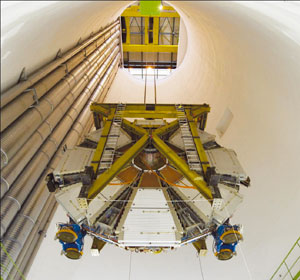The ATLAS collaboration celebrated lowering the final large piece of the detector into the underground cavern on 29 February. The event marked a major milestone for the muon spectrometer group, as well as the final installation of large detector components below ground.
ATLAS is the world’s largest general-purpose particle detector, measuring 46 m long, 25 m high and 25 m wide. It weighs 7000 tonnes and consists of around 100 million sensors that will measure particles produced in collisions in the LHC. The first major piece was installed in 2003 and since then, many detector elements have journeyed down the 100 m shaft into the cavern. This last piece completes the gigantic puzzle.

Modest in scale compared with the large 25 m diameter muon spectrometer wheels, this last element is one of two pieces known as the “small” wheels, the first having descended into the cavern two weeks earlier. Both small wheels measure 9.3 m in diameter and weigh 100 tonnes, including massive shielding elements. Unlike the large wheels, whose assembly was completed in the cavern, they were assembled on the surface on CERN’s main site and then transported slowly and carefully by road transport across to the ATLAS cavern at Point 1 on the LHC ring.
The whole muon spectrometer system would cover an area equivalent of three football fields, and includes 1.2 million independent electronic channels. The small wheels, which complete the system, are closest to the interaction point in the small-angle region, next to the calorimeter and the two end-caps of the toroid magnet. Each small wheel consists of two discs placed one against the other and slotted together with a central cylindrical component. One wheel provides shielding, which will absorb particles other than muons, while the other acts as the support for the detection chambers. Three of the four different kinds of muon chamber found in ATLAS are fitted onto the small wheels, including trigger chambers and two types of precision chamber – cathode strip chambers and monitored drift tubes – which will allow the muon tracks to be reconstructed with a precision of 10 μm.
The ATLAS muon-spectrometer group comprises 450 physicists from 48 institutions, and includes members from China, France, Germany, Greece, Israel, Italy, Japan, the Netherlands, Russia and the US. They have spent more than a decade developing, planning and constructing the ATLAS muon spectrometer, with the shielding elements constructed in Armenia and Serbia.





